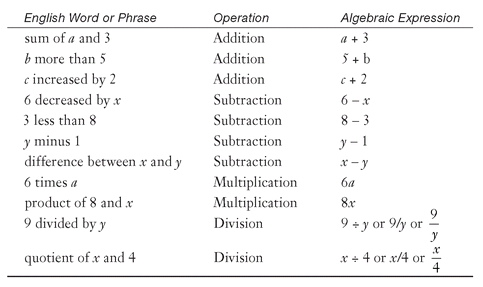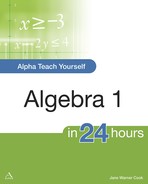Hour1
Algebraic Expressions
Algebra is simply a language that lets you speak efficiently about numbers and how they relate. For example, when you first learned that “five plus two is seven,” it was probably written like this:
And when you first learned that “five times two is ten,” it was probably written like this:
A more efficient way to write these statements is: 5 + 2 = 7 and 5 · 2 = 10. This is algebra at its simplest. What was a math problem has now become an algebraic sentence. It contains the most basic algebraic symbol, the equals sign. This small but mighty symbol has revolutionary power because it allows you to equate two things that really look quite different from each other. Writing and solving equations is probably the most important work you do in algebra.
GO TO ▶
You’ll learn more about equations and how to solve them in Hour 5.
Recognizing New Symbols for Multiplication and Division
Learning some basic definitions in the language of algebra will give you the framework you need. The terms in the two original questions are 5 and 2, and the operation is adding in the first expression and multiplying in the second. The 5 and 2 are specific numbers. But in algebra, the terms can be variables, a key word based on “to vary” or “to change.” If you change 5 + 2 = 7 (which you know is true) to x + 2 = 7, you’ve created an equation that may or may not be true, depending on the value of the variable x.
Many fundamental rules, definitions, and visual representations are the same in arithmetic and algebra, and others are unique to algebra. The + and - signs that show adding and subtracting in basic arithmetic are the same signs you use for adding and subtracting algebraic terms.
But be aware that multiplying terms in algebra can be indicated in a few different ways. To avoid any confusion by writing “7 times x” as 7 × x (with the multiplication symbol looking a lot like the variable x), you’ll usually see 7x, 7 · x, or (7)(x) in algebraic expressions. The division symbol, as in a ÷ 12, is the same in algebra and arithmetic, but division will sometimes appear as a/12 or, most often, as  .
.
A lot of the work in algebra involves simplifying long expressions that have many terms. Sometimes special symbols will guide you, and in other problems you’ll need to know some rules. Fortunately, these symbols and rules are easy to recognize and use.
STRICTLY DEFINED
Simplifying expressions means using the grouping symbols to combine the terms using the operations of +, -, ×, and ÷ in the problem. The grouping symbols most commonly used are parentheses, ( ), or brackets, [ ].
Understanding Grouping Symbols
Let’s begin with expressions that have only numbers and no variables. In 6 + (18 ÷ 2), you are trying to combine the numbers. The parentheses act like grouping symbols and tell you to first divide 18 by 2 and then add 6 to the result, which gives you a result of 15. In (6 + 18) ÷ 2, doing what’s in the parentheses first gives a result of 24, and dividing that by 2 gives you 12. This shows the importance of obeying the grouping symbols, because 15 and 24 are very different answers!
STRICTLY DEFINED
Combining terms means using the grouping symbols to simplify the problem. The grouping symbols most commonly used are parentheses, ( ), or brackets, [ ].
Now try these and check your answers on page 8:
1. Simplify: 8 + (6 · 3)
2. Simplify: (8 + 6) · 3
3. Simplify: 2(6 - 2) + 4(7 - 5)
Following the Rules for Order of Operations
Combining the numbers in problem 3 from the previous section will lead you to an expression without parentheses. Look at it again:
2(6 - 2) + 4(7 - 5) = 2 · 4 + 4 · 2
This situation requires knowing what to do when there is more than one operation and no parentheses. The correct order for what operation to do first is:
If there are no parentheses:
1. Multiply and divide first.
2. Then add and subtract.
For example, there are no parentheses in the following problem, so here is how to simplify it.
Simplify:
12 + 16 ÷ 2 - 1 · 3 =
12 + 8 - 3 =
20 - 3 =
17
12 + 8 - 3 =
20 - 3 =
17
In this example, if you had just worked from left to right, doing the operations as they appear, you would get 39, which is not correct. Using the rules for order of operations, you must do the multiplying and dividing before any adding or subtracting. So the 16 is divided by 2, and the 1 is multiplied by 3. The 12 and 8 are added, and the 3 is subtracted. If the problem includes many operations and also parentheses, do what’s in the parentheses first.
Now try these problems and check your answers on page 8:
4. Simplify: 20 + 12 ÷ 2 - 4 · 3
5. Simplify: 15 ÷ (10 - 7) - 1 · 4
6. Simplify: (4 + 3) - (8 - 5) + 16 ÷ 2 - 2 · 3
You have been using division of single numbers in many of the examples. Division in algebra problems is usually shown as a fraction and can often include more than one term in the numerator or denominator. When it is in this form and you are simplifying, first work on the numerator, then work on the denominator, and then divide the results.
STRICTLY DEFINED
Remember that the upper part of a fraction is called the numerator and the lower part is called the denominator.
For example:
Now try these problems and check your answers on page 8:
7. 
8. 
Now that you have practiced simplifying expressions that include different operations and grouping symbols, it’s time to put those skills to work in problems that have variables.
Solving Practical Problems with Algebraic Expressions
An expression that includes variables can be evaluated, if you know the values for the variables. Follow the same rules for order of operations that you have already learned.
JUST A MINUTE
If there are parentheses, do what is inside them first. Then do the multiplying and dividing, as they appear from left to right. Then do the adding and subtracting, as they appear from left to right.
If there are no parentheses, multiply and divide first, from left to right, and then add and subtract, from left to right.
Evaluate: 6x - 7y + 2, given x = 4, y = 3
Answer: Substitute the numbers for the variables.
6 · 4 - 7 · 3 + 2 = 24 - 21 + 2 = 5
Evaluate: 2x - 5, given x = 7
Answer: 2 · 7 - 5 = 14 - 5 = 9
Evaluate: 2(x - 5), given x = 7
Answer: 2(7 - 5) = 2(2) = 4
Now try these problems and check your answers on page 8:
9. Evaluate: 2a + 4 - 5b, given a = 6 and b = 2
10. Evaluate: 12 - 6x - 2y + 5, given x = 1 and y = 3
Several English phrases indicate addition, including increased by, more than, and added to. The following table lists these phrases, their operations, and their algebraic expressions.

Referring to the previous table, write each of the following phrases as algebraic expressions. Use x as the variable. Check your answers below.
11. Five times a number
12. The sum of 2 and a number
13. Three times a number, decreased by eight
14. Twelve decreased by seven times a number
15. Eight times the sum of a number and 3
16. 9 plus the quotient of a number and 6
Answers to Sample Problems in Hour 1
1. 8 + (6 · 3) = 8 + 18 = 26
2. (8 + 6) · 3 = 42
3. 2(6 - 2) + 4(7 - 5) = 2 · 4 + 4 · 2 = 8 + 8 = 16 (If you had trouble with the third step in this solution, don’t worry. It is explained in the section “Order of Operations”) on page 5
4. 20 + 12 ÷ 2 - 4 · 3 = 20 + 6 - 12 = 26 - 12 = 14
5. 15 ÷ (10 - 7) - 1 · 4 = 15 ÷ 3 - 4 = 5 - 4 = 1
6. (4 + 3) - (8 - 5) + 16 ÷ 2 - 2 · 3 = 7 - 3 + 8 - 6 = 4 + 8 - 6 = 12 - 6 = 6
7. 
8. 
9. 2a + 4 - 5b, given a = 6 and b = 2; 2 · 6 - 5 · 2 = 12 + 4 - 10 = 6
10. 12 - 6x - 2y + 5, given x = 1 and y = 3; 12 - 6 · 1 - 2 · 3 + 5 = 12 - 6 - 6 + 5 = 5
11. 5x, 5 · x, or (5)(x)
12. 2 + x
13. 3x - 8
14. 12 - 7x
15. 8(x + 3)
16. 9 + x ÷ 6 or 9 + x/6 or 
Review
Hour’s Up!
Based on what you’ve learned in Hour 1, do the following problems about algebraic expressions. Check your answers with the solution key in Appendix B.
1. Simplify: 10 - (2 + 5) + (8 - 2)
a. 7
b. 5
c. 9
d. 3
2. Simplify: (10 - 2) + (5 + 8) - 2
a. 12
b. 19
c. 20
d. 21
3. Simplify: (2 + 7) - (6 - 1) + 9 · 2 + 8 ÷ 4
a. 32
b. 30
c. 15
d. 24
4. Simplify: 
a. 4
b. 2
c. 3
d. 1
5. Simplify: 
a. 3
b. 5
c. 7
d. 9
6. Evaluate: 2a - 6b + 12 - c, given a = 3, b = 1, and c = 10
a. 8
b. 5
c. 2
d. 1
7. Evaluate: 9 + (x - 3) - (12 - y) - 5, given x = 5 and y = 7
a. 1
b. 8
c. 4
d. 2
Write the following phrases as algebraic expressions:
8. 6 increased by the product of x and 3
a. 6 + 3 ÷ x
b. 6 + 3x
c. 6 + 3 - x
d. 6 - 3x
9. 5 subtracted from the sum of a and y
a. 5 - (a - y)
b. 5 - (a + y)
c. (a + y) - 5
d. (a - y) - 5
10. c decreased by the sum of 4 and d
a. c - (4 - d)
b. c - (4 + d)
c. (4 - d) - c
d. (4 + d) - c
..................Content has been hidden....................
You can't read the all page of ebook, please click here login for view all page.
